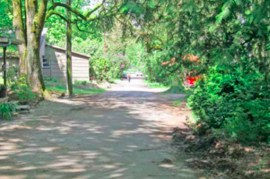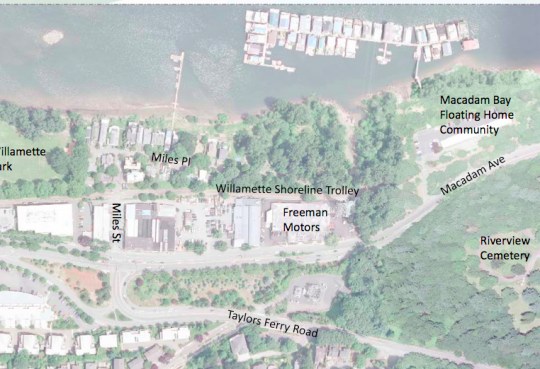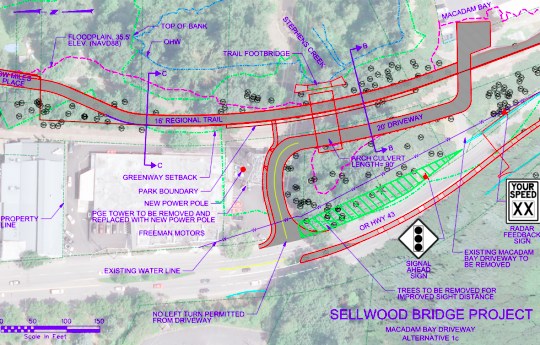
this into a larger road to handle 200
extra cars daily.
(Photo: Multnomah County)
The construction of the new Sellwood Bridge is already having some impacts on the nearby transportation network. As The Oregonian reported last month, a decision to relocate an access road to Highway 43 for the Macadam Bay houseboat community just north of the bridge “ignited a fierce debate”.
At issue was where to put the estimated 200 cars that go between the houseboats and the highway every day. The county considered a myriad of options, but there was opposition to each of them. Of particular interest to readers of this blog is that the Willamette Greenway trail begins on SW Miles Place and runs parallel to Highway 43 in this same area. Also, as part of the Sellwood Bridge project, the trail will be improved and connected to the bridge.
Here’s an aerial view of the area in question (supplied by Multnomah County):

If the houseboat traffic was put onto Miles, it would have meant that a portion of the future trail would be a shared auto/bike environment. With an additional 200 cars, Miles would be more congested and, due it being rebuilt with full curbs and sidewalk, the traffic would likely have been higher speed as well.
Roger Robinson, who lives in the area and has been attending the Community Advisory Committee (CAC) meetings for several months, began alerting me to this situation back in April. At that time he was very concerned that SW Miles Place would be rebuilt to accomodate the additional auto traffic and that the quality of the future trail could be in jeopardy. Another red flag was raised in The Oregonian article after a CAC meeting last month:
“One group not heard from at the meeting? Trail users. Hundreds of people walk, jog and cycle down the middle of Miles Place on weekends. After the new bridge goes in, that is expected to rise into the thousands.”
Fortunately, despite trail users not speaking up and Robinson’s fears, it looks like a good solution has been found (thanks in large part to the work on the CAC by BTA citizen rep Richard Marantz and PBOT’s bike planner Roger Geller and citizen activist Roger Averbeck — both of whom were involved in the planning.)
The CAC has opted to create a new driveway and access road just south of the Freeman Motors parking lot. Robinson said this is “great news” because it’s the only option that keeps traffic separated from the trail. (Houseboat owners aren’t nearly as thrilled, because they were hoping for a more private, exclusive driveway.)
Multnomah County spokesman Mike Pullen shared a plan drawing of the CAC’s preferred alternative (note the 16-foot “regional trail” and SW Miles Place in the upper left):

The cost of this recommended option is estimated at around $4 million. From here, there’s another meeting on June 18th and then this will be folded into the final design package that will be voted on by the Multnomah County Board of Commissioners on June 21st.
Now the fun work begins of designing the new segment trail that will connect from the Sellwood Bridge to Willamette Park via Miles Place. Stay tuned and check out SellwoodBridge.org to learn more.

